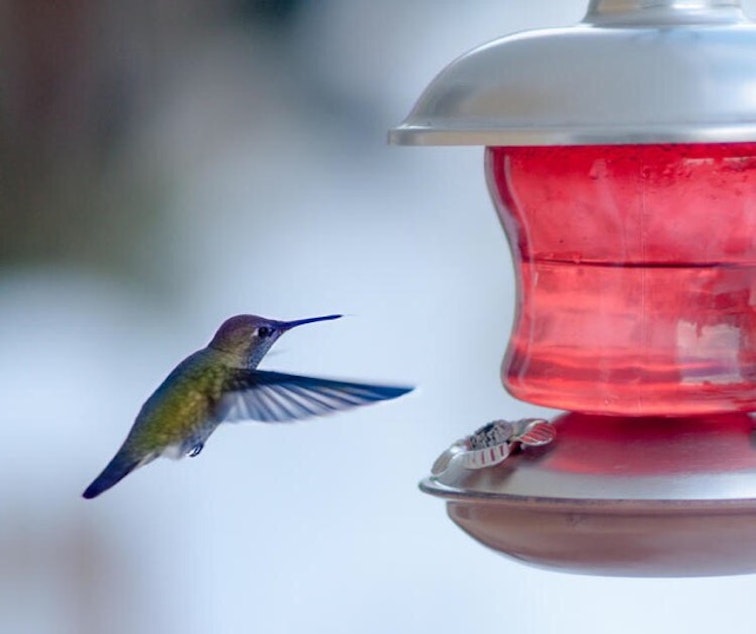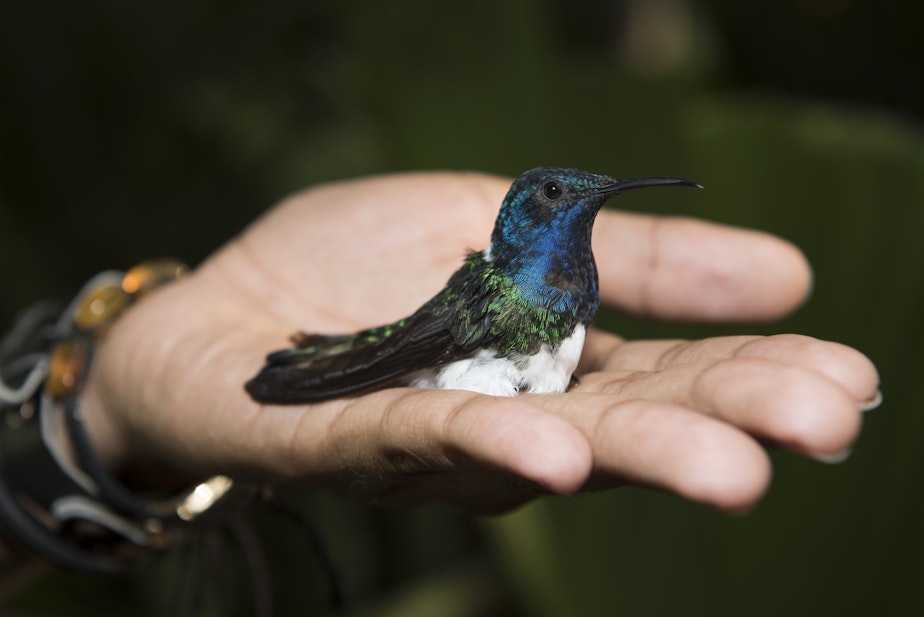UW researcher slows down hummingbirds to study them. What he found is amazing

Alejandro Rico-Guevara remembers when he first realized he was a hummingbird guy, not like an "I fill my hummingbird feeder every week" type of guy, but an “I want to know everything about these birds” type of guy.
He was on a field trip through the Amazon rainforest, looking for spiders. It was mostly quiet on the trip, no animals to be seen, then, a hummingbird showed up.
"Hummingbirds are different," said Rico-Guevara, an associate professor of biology at the University of Washington and the curator of birds at the Burke Museum.
"They are very bold, which is very interesting because of their size," he said. "Tiny birds, you would imagine that would be scared of you. "
The bird wasn't scared and Rico-Guevara realized why they might be braver than the bigger animals.
Sponsored
"Probably because of their capabilities like flight, for instance, they're so fast, they may not be as scared as others," he said. It was a moment of realization for Rico-Guevara
"There is so much to learn about them and their personality," he said.
For the first time in his life, Rico-Guevara saw hummingbirds completely differently, and it changed him.
Since then, he’s dedicated his life to looking at hummingbirds in ways other people can’t. What he’s learned changed the world’s understanding of hummingbirds and, at times, has been of great use to humans.

Sponsored
In the Life Sciences Building at the University of Washington, Rico-Guevara led visitors down a labyrinthine series of hallways to a small room. Inside the room were two doctoral students, some cameras, some complicated-looking machines, and a cage.
The center of attention in the room was a small Anna’s Hummingbird, no more than a few inches tall, flying around the cage. There was a feeder, which occasionally opened up and the hummingbird hovered toward it. The students were collecting data on hummingbirds' respiration rate while feeding.
Hummingbirds move quickly and to understand them, Rico-Guevara and his students use high frame-rate cameras. A movie or TV show has 24 or 30 frames per second. Rico-Guevara's cameras record anywhere from 200 to 1,000 frames per second.
When those videos are slowed down, there’s a lot of visual information, which gives Rico-Guevara incredible insight into this bird’s life.
Take, for example, how hummingbirds fight.
Sponsored
"What you perceive like a blur, and quick motion," Rico-Guevara said. "When you slow down that action, a lot is happening."
That fighting is often brutal. Hummingbirds use their talons and beaks to grab, poke, and jab each other in midair. Rico-Guevara said he’s even seen a hummingbird grasp another with its talons and carry it away from a feeder, a move he likened to a soccer player grabbing the jersey of an opponent.
When Rico-Guevara slowed down the video of hummingbirds fighting, he saw that they appeared to be sword fighting with their bills. That’s something he knows quite a bit about. He fences, and his father-in-law even does so at the Olympic level. What Rico-Guevara saw the hummingbirds doing looked very familiar.
"Hummingbirds when they fly against each other, you can see this invisible force field between the two of them, which I think is exactly the same that you see in fencing bouts," he said.

Sponsored
R
ico-Guevara’s hummingbird research also has very direct, tangible, real-world benefits: swabs. In one of his first research projects, he looked at hummingbird’s tongues.
Scientists used to believe that hummingbirds used their tongues to suck up nectar like a straw. What Rico-Guevara saw was that basically, the tongue unfurls and extends little fringes. In the slow motion videos, the tongue almost looks like a squid, tentacles expanding into the liquid nectar.
"When [hummingbirds] pull it out, those little fringes close on themselves and trap little droplets," Rico-Guevara said.
This all happens quickly, over and over again. For the energy-dependent birds, it’s efficient, because the droplets just stick to their tongues.
A few years ago, people became intimately familiar with the hummingbird’s tongue mechanism. Rico-Guevara’s research was used to design more efficient swabs for Covid tests.
Sponsored
These little things have large applications sometimes, Rico-Guevara is continuing to look at hummingbirds — their metabolic rate, the small serrations in their bills, and the co-evolution of common nectarivore traits across the world.
Is there any direct use for this information? Possibly, but there’s another value here and you don’t even need a special camera to see it.
Rico-Guevara calls hummingbirds important ambassadors of the natural world. If you walk down any street in Seattle, you’ll likely see at least one hummingbird feeder, sometimes a cluster of them in the same residence. There’s a fascination with these birds.
"People connect with nature, because they have amazing creatures in their yards and they want to protect them, they want to know more about them," Rico-Guevara said.





